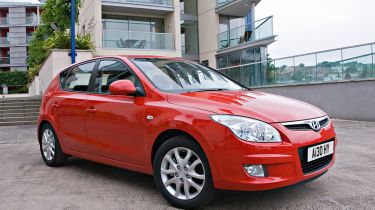Hyundai i30 Hatchback (2007-2012) review
The Hyundai i30 offers lots of car for your money

In a sector as competative as this, each model needs its unique selling point. The Hyundai i30 delivers refined dynamics, economical engines and plenty of kit, all for rock-bottom prices. Rivals like the Ford Focus and the i30's sister car the Kia Cee'd are more engaging to drive, but the i30's comfort levels and excellent reliability set it apart. For no frills family motoring this Korean hatchback is hard to beat.
Engines, performance and drive
The i30 steers far better than Hyundais of old, but it's clear that some body control in the corners has been sacrificed in pursuit of ride comfort. And that's no bad thing, the i30 deals with bumps well and is an accomplished long-distance cruiser on motorways. The entry-level 89bhp 1.6-litre CRDi engine is coarse at low revs and near the red-line, but smooth and refined in the mid-range, where the majority of the power is anyway. Also available are 1.4 and 16-litre petrol engines with 108bhp and 124bhp respectively - these are more refined than the diesel, but lack torque for overtaking.
MPG, CO2 and Running Costs
Choose your model wisely and the i30 will cost peanuts to run. It's priced at almost £2,000 less than the equivalent Ford Focus and, if you opt for the 89bhp diesel model (stop-start is a £205 optional extra), you should see returns of more than 60mpg. Unfortunately the most economical diesel is only available in the most basic 'Classic' trim, although you still get air-con and electric front windows as standard. Hyundai's residuals tend to be slightly higher than Kia's, too. Higher-spec Comfort and Premium models get a leather steering wheel and metal-effect centre console.
Interior, design and technology
The Hyundai i30 is a smart and well-proportioned car that can hold its head high next to more expensive rivals like the Ford Focus and Vauxhall Astra. Entry-level models make do with black door handles and wheel trims instead of alloys, as well as a rough plastic finish for the steering wheel and a cheap rubber gearknob that make the penny-pinching obvious.
Practicality, comfort and boot space
Flip the rear seats down and you can create a flat loading area, although a high lip can make loading heavier items a chore. With the rear seats down, capacity increases from 340 litres to 1,250 litres, too – that's more than the Ford Focus. A luggage net is included on all models to help keep awkward items in place in the boot, and the glovebox is air-conditioned – perfect for keeping drinks cool in the summer months. Headroom is generous in the rear although legroom can be restricted with two tall adults sat behind each other - a shame considering the i20 is one of the largest cars in its class.
Reliability and Safety
Top of the i30's list of attractions, is the fact it scored a category win for best compact family car in our 2011 Driver Power survey. When it was originally crash tested by Euro NCAP it achieved four stars, but the safety organisation highlighted that the dashboard could injure passenger's knees. Hyundai made a raft of changes and when it was retested in 2008, it scored the full five stars. Hyundai's five-year warranty – although not as lengthy as Kia's seven-year scheme – is unlimited mileage compared to Kia's capped 100,000-mile policy.







